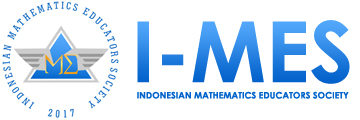Systematic Literature Review: Ethnomathematical Context of Batik Motifs in Mathematics Learning
DOI:
https://doi.org/10.35706/sjme.v8i2.11370Abstract
This study aims to determine whether ethnomathematics of batik motifs can be used as a mathematics learning approach and implemented in schools. The results of identifying articles from 2013 to 2023 through systematic literature review (SLR) referring to the Preferred Reporting Items for Systematic Review and Meta Analysis (PRISMA) obtained 12 sinta articles from a database of 200 articles. The findings of the SLR are two types of articles that are implemented directly to students in schools and only examine ethnomathematics from various batik motifs, geometry transformation material obtained from all articles
Downloads
References
Abi, A. M. (2017). Integrasi Etnomatematika Dalam Kurikulum Matematika Sekolah. JPMI (Jurnal Pendidikan Matematika Indonesia), 1(1), 1. https://doi.org/10.26737/jpmi.v1i1.75
Atiyah, K., & Priatna, N. (2023). Analysis of the Connecting, Organizing, Reflecting and Extending (CORE) Model to Improving the Mathematical Reasoning Ability Students. SJME (Supremum Journal of Mathematics Education), 7(2), 157–167. https://doi.org/10.35706/sjme.v7i2.7746
Chrissanti, M. I. (2019). Etnomatematika sebagai salah satu upaya penguatan kearifan lokal dalam pembelajaran matematika. Math Didactic: Jurnal Pendidikan Matematika, 4, 243–252. https://doi.org/10.33654/math.v4i0.191
Clarice, L. (2018). Eksperimentasi Teknik Efek Dengan Cetakan Pada Fabrik Dalam Penghasilan Produk Tekstil. UNIMAS: Universiti Malaysia Sarawak.
Deda, Y. N., & Amsikan, S. (2019). Geometry Concept on the Motifs of Woven Fabric in Kefamenanu Community. JRAMathEdu (Journal of Research and Advances in Mathematics Education), 4(1), 23–30. https://doi.org/10.23917/jramathedu.v4i1.6253
Devi Purwanti, Zaenuri, & Mohammad Asikin. (2021). Kemampuan Pemecahan Masalah dalam Model Pembelajaran Problem-Based Learning Berbasis Etnomatematika. Jurnal Pendidikan Dasar, 10(1), 113–120.
Hindun Permatasari, V., & Dwi Kurniasih, M. (2021). THE ANALYSIS OF MATHEMATICAL LITERACY ON PLANE GEOMETRY MATERIAL WITH BATIK BETAWI TUMPAL PATTERN. Kalamatika: Jurnal Pendidikan Matematika, 6(1), 83–98. https://doi.org/10.22236/KALAMATIKA.vol6no1.2021pp83-98
Ishartono, N., & Ningtyas, D. A. (2021). Exploring Mathematical Concepts in Batik Sidoluhur Solo. International Journal on Emerging Mathematics Education, 5(2), 151. https://doi.org/10.12928/ijeme.v5i2.20660
Iskandar, R. S. F., Karjanto, N., Kusumah, Y. S., & Ihsan, I. R. (2022). A systematic literature review on ethnomathematics in geometry.
Lestari, M., Rahayu, W., & Irawan, A. (2022). Trial And Validation Of Etnobatic Applications As A Media Mathematics Learning Based On Android. Jurnal Math Educator Nusantara: Wahana Publikasi Karya Tulis Ilmiah Di Bidang Pendidikan Matematika, 8(2), 107–118. https://doi.org/10.29407/jmen.v8i2.18378
Maryati, M., & Prahmana, R. C. I. (2021). Learning Trajectory of Dilation and Reflection in Transformation Geometry through the Motifs of Bamboo Woven. Jurnal Didaktik Matematika, 8(2), 134–147. https://doi.org/10.24815/jdm.v8i2.21283
Noerhasmalina, N., & Khasanah, B. A. (2023). The geometric contents and the values of local batik in Indonesia. Jurnal Elemen, 9(1), 211–226. https://doi.org/10.29408/jel.v9i1.6919
Permita, A. I., Nguyen, T.-T., & Prahmana, R. C. I. (2022). Ethnomathematics on the Gringsing batik motifs in Javanese culture. Journal of Honai Math, 5(2), 95–108. https://doi.org/10.30862/jhm.v5i2.265
Pertiwi, M., Suhendra, S., & Juandi, D. (2022). Mathematical Literacy Ability of Junior High School Students in Terms of Self-Efficacy. SJME (Supremum Journal of Mathematics Education), 6(2), 171–180. https://doi.org/10.35706/sjme.v6i2.6547
Prahmana, R. C. I., & D’Ambrosio, U. (2020). LEARNING GEOMETRY AND VALUES FROM PATTERNS: ETHNOMATHEMATICS ON THE BATIK PATTERNS OF YOGYAKARTA, INDONESIA. Journal on Mathematics Education, 11(3), 439–456. https://doi.org/10.22342/jme.11.3.12949.439-456
Santri, D. D., Hartono, Y., & Somakim, S. (2018). Pemodelan Matematika Untuk Belajar Aljabar. UNION: Jurnal Ilmiah Pendidikan Matematika, 6(3), 297–306. https://doi.org/10.30738/union.v6i3.2201
Sari, A. K., Budiarto, M. T., & Ekawati, R. (2022). Ethnomathematics study: cultural values and geometric concepts in the traditional “tanean-lanjang” house in Madura – Indonesia. JRAMathEdu (Journal of Research and Advances in Mathematics Education), 7(1), 46–54. https://doi.org/10.23917/jramathedu.v7i1.15660
Sharma, T., & Orey, D. C. (2017). Meaningful Mathematics Through the Use of Cultural Artifacts (pp. 153–179). https://doi.org/10.1007/978-3-319-59220-6_7
Sudrajat, S., Winarto, A., & Wicaksono, B. (2023). Ethnomathematics of Kalimantan Batik in field Geometry learning in elementary school. International Journal of Trends in Mathematics Education Research, 6(1), 26–32. https://doi.org/10.33122/ijtmer.v6i1.172
Sunandar, M. A. (2017). Pembelajaran Matematika SMK Bernuansa Etnomatematika. PRISMA, Prosiding Seminar Nasional Matematika, 95–105.
W. Wahyudin. (2018). Etnomatematika Dan Pendidikan Matematika Multikultural. Seminar Nasional Pendidikan Matematika.
Wahyudi, H., Widodo, S. A., Setiana, D. S., & Irfan, M. (2021). Etnomathematics: Batik Activities In Tancep Batik. Journal of Medives : Journal of Mathematics Education IKIP Veteran Semarang, 5(2), 305. https://doi.org/10.31331/medivesveteran.v5i2.1699
WARLI, D., & Musa, S. (2022). EKSPLORASI ETNOMATEMATIKA DAN ETNOSAINS (ETNOMATHSAINS) PADA BATIK BOMBA. Koordinat Jurnal MIPA, 3(1), 33–38. https://doi.org/10.24239/koordinat.v3i1.37
Zulfah, Z., Astuti, A., Hermira, E., Elviana, M., Ernalira, P., & Malinda, Y. (2023). Eksplorasi Etnomatematika Busana Ninik Mamak di Kabupaten Kampar. Journal of Education Research, 4(1). https://doi.org/10.37985/jer.v4i1.136
Downloads
Published
How to Cite
Issue
Section
License

This work is licensed under a Creative Commons Attribution-ShareAlike 4.0 International License.
Authors who publish with this journal agree to the following terms:
- Authors retain copyright and grant the journal right of first publication with the work simultaneously licensed under a Creative Commons Attribution License that allows others to share the work with an acknowledgment of the work's authorship and initial publication in this journal.
- Authors are able to enter into separate, additional contractual arrangements for the non-exclusive distribution of the journal's published version of the work (e.g., post it to an institutional repository or publish it in a book), with an acknowledgment of its initial publication in this journal.
- Authors are permitted and encouraged to post their work online (e.g., in institutional repositories or on their website) prior to and during the submission process, as it can lead to productive exchanges, as well as earlier and greater citation of published work (See The Effect of Open Access).










